
Medina the Radiant
It was in this miraculous oasis—gentle, hospitable and full of bounties— that the last years of the life of the Blessed Prophet were spent, where the first Islamic community was established, where the Prophet died, and where many of his companions and closest members of his family are buried. The earth of Medina is blessed by the fact that it contains the body of God’s last chosen prophet, a blessedness that one feels while walking on its hallowed ground. No wonder that in days of old many a pious man would dismount from his horse a long way outside of the city and would walk the rest of the way in order to be respectful of the land that contains in its bosom the earthly remains of such a precious being. Even a generation ago, Medina was like a vast garden, with majestic palm trees surrounding the houses and markets of the city, giving an impression of plentitude and bounty. One might, in fact, say that whereas Mecca represents the reality of the Divine as the Absolute, Medina reflects His reality as the Infinite. There is a feminine quality to the city in the sense that it is not harsh but gentle. Even its people display the trait of gentleness, reflecting the character of the Prophet about whom the Noble Qur’an has said: “O thou art of a tremendous Character.”

Evening prayers at the Mosque of the Prophet (Masjid al-Nabi), 1996. During the twenty days preceding and following the annual Hajj, nearly all of the two million pilgrims visit Medina as well but they are not all there at the same time, as is the case with Mecca.

Pilgrims heading for the evening (maghrib) prayers through the marble-floored complex of the Mosque of the Prophet. Usually the maghrib prayers are the most crowded.
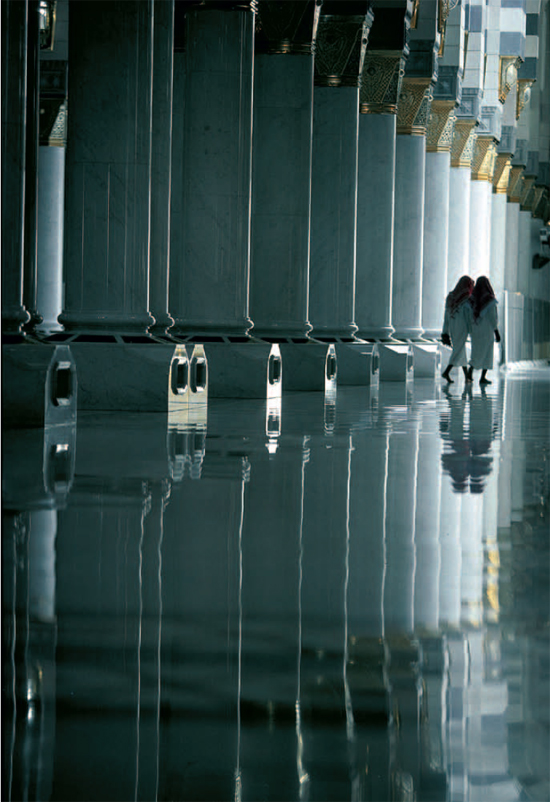
A view of a section of the inside of the Mosque of the Prophet, part of the extension completed in 1995. The new parts of the mosque have elaborate air-conditioning and a cooling water system to compensate for the extreme heat, especially during the summer season.
After all, this is the abode of the Prophet dominated by his mausoleum and mosque. His barakah is felt throughout the confines of the town. The heart yearns to visit Medina precisely because this is the city of the Prophet, its mosque the model of all mosques, its traditions the source of so many Islamic practices. To love God one must love His Prophet. To love Mecca also requires loving Medina. The two cities, in fact, form a single sacred reality for the vast majority of Muslims who live outside their vicinity, a reality at once blessed and luminous. Yes, there is indeed something of the Muhammadan Light, the light associated with the inner reality of the Blessed Prophet that still emanates in his city and bestows upon Medina a special barakah, a sweet presence which is associated with the being whom it welcomed to its fold, the being who is interred in its earth and who made Medina the capital of a vast new order.
Although that political order no longer exists as a unity, this first capital of the Islamic world continues to be loved by all Muslims near and far. Today, as in days of old, all the faithful pray for the opportunity to be able to experience the Muhammadan barakah which is still so palpable within the confines of this “illuminated city”, still the capital of the Blessed Prophet’s dominion.
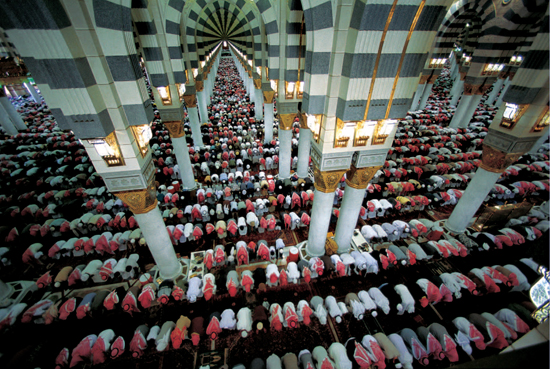
The Friday congregational prayer at the Mosque of the Prophet is always attended by the people of Medina as well as pilgrims. That is why the space holding 190,000 worshippers invariably becomes full and many listen to the sermon (khutbah), which forms part of the Friday prayers, outside under the heat of the sun.

This photograph, taken with special permission at midnight when the Mosque of the Prophet was closed, shows the southern wall of the room (known as the “Blessed Room” by Muslims) in which the Prophet is buried with Abu Bakr and Umar, the first two caliphs, beside him.

The mihrab or prayer niche built in the direction of Mecca before which the Blessed Prophet himself prayed. This mosque was built by the Prophet adjacent to his dwelling when he first migrated from Mecca to Medina.

The Mosque of the Prophet adjacent to the Prophet‘s tomb is, along with the Ka’bah, the most sacred place for Muslims.
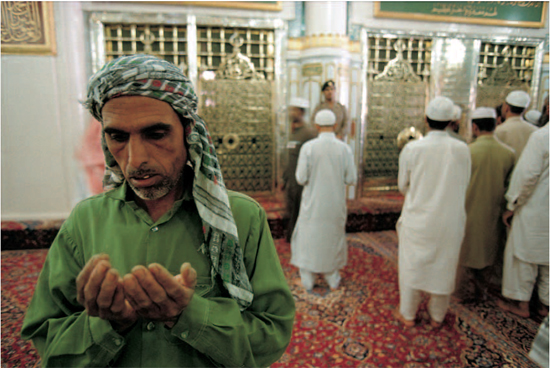
Pilgrims offering prayers next to the tomb known as the Blessed Prophet’s meeting room. Pilgrims are forbidden to enter the chamber containing the Prophet’s tomb and it is therefore here that they feel closest to him. It is here that their hearts are most uplifted, with most pilgrims praying intensely with tears in their eyes.

The Wahhabi, who dominate religious life in Saudi Arabia, oppose visitation of the tombs of saints, but offering prayers at the tomb of the Blessed Prophet is permitted. The love of the Blessed Prophet is central in Islam.

A young Pakistani boy, son of a laborer in Medina, praying with the use of his rosary (subhah) while awaiting the time of the canonical prayers (salat).

A pilgrim from West Africa reciting the Qur’an in the vast space of the Mosque of the Prophet outside the period of the Hajj. The short pilgrimage (al-umrah) can be and is performed by numerous people throughout the year so that the wave of pilgrims to Mecca and Medina never ceases.
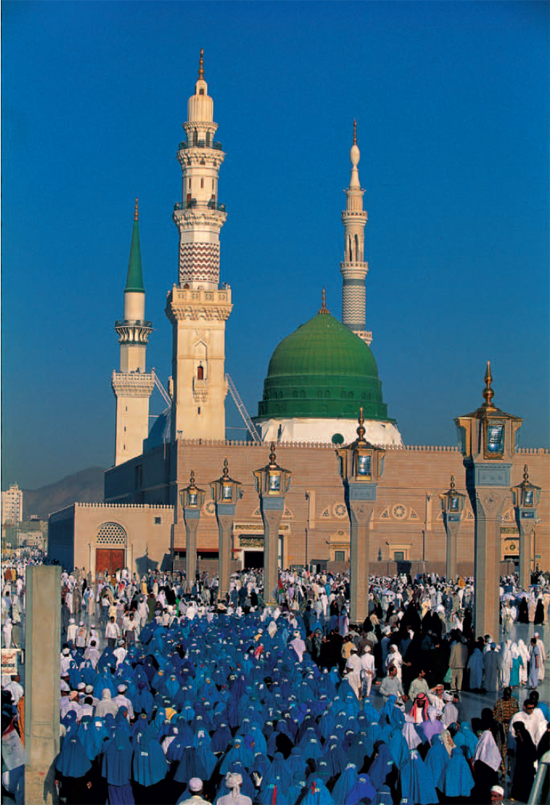
The tomb of the Blessed Prophet Muhammad—may peace and blessings be upon him—in Medina. The green-colored dome and the Ka’bah are the two most recognizable symbols of the religion of Islam.
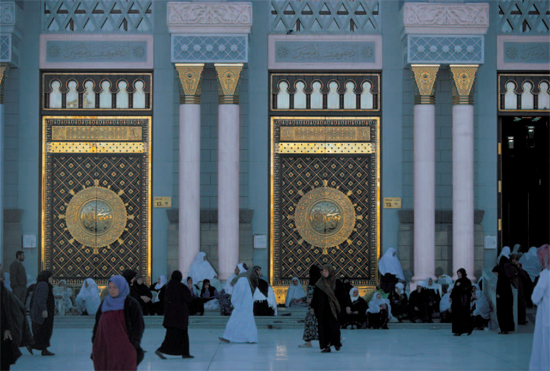
The extension of the Mosque of the Prophet in Medina, which was completed in 1995, has provided seating capacity for some 260,000 for prayers. With the outside space all covered with marble, there is enough room for a million people to pray at the mosque, making it the second largest mosque in the world after the Grand Mosque of Mecca.

People coming out of the Mosque of the Prophet after the maghrib prayers when all the shops around the mosque open their doors again and the area becomes very lively. As for restaurants, they begin to serve food after the isha prayer.

Two female pilgrims walk at dusk in the enclosure of the Mosque of the Prophet, where the floor is lavishly decorated with an arabesque pattern.

An aerial view of al-Baqi cemetery, the oldest and historically the most significant cemetery in Medina.

During the holy month of Ramadan, the most sacred month of the Islamic calendar, all adult Muslims who have the physical capability are obliged to fast from dawn to sunset. Here, pilgrims are offered food to break their fast at the Mosque of the Prophet.

Saudi children help in the preparation of the meal to break the fast (iftar). Wealthier Muslims by tradition prepare food for the needy at this time. Here, during every evening of Ramadan, wealthy Saudi families provide iftar for whoever requests it.

People being offered iftar in Medina. Other than pilgrims, laborers often participate in these free meals. Feeding the poor is a religious obligation in Islam.

A woman pilgrim from Indonesia has wandered into an area designated for men and is awaiting the time to break the fast. In the early days of Islam, iftar consisted usually of dates, bread and water but now a variety of dishes are prepared for the occasion.

Over a hundred thousand people are having iftar in the vast garden surrounding the Mosque of the Prophet. Before breaking their fast, people offer a prayer of thanksgiving to God for having been able to fast during the day.

The early prayers on the morning after the end of Ramadan marking the Id al-fittr, which is the great Muslim holiday. On this occasion, over a million people consisting of pilgrims as well as the people of Medina come to the Mosque of the Prophet, the worshippers overflowing to the spaces around the mosque.

A total of 250 umbrellas shade the huge enclosure surrounding the Mosque of the Prophet. Designed to protect pilgrims at prayer from the fierce Arabian sun, the umbrellas are opened in two stages from five o’clock in the morning and closed around sunset.
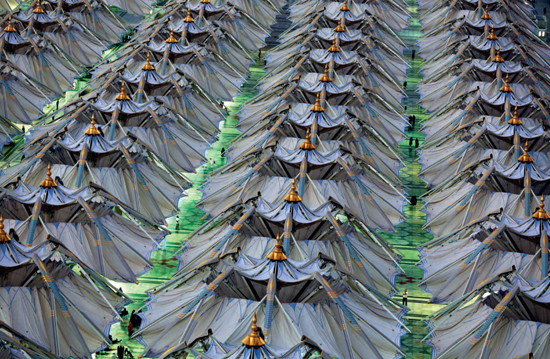
Made of non-flammable material to protect pilgrims in case of fire, the square umbrellas are massive, measuring 25.5 x 25.5 meters. It takes approximately three minutes for them to unfold, which is done with an electric system. Installation began in 2008 and took three years.

All the umbrellas closed down tightly for the night, pilgrims gather in the enclosure of the Mosque of the Prophet for the isha prayers.

Early in the morning, the umbrellas begin to open in unison. The opening of the umbrellas starts with no warning or sound, and pilgrims who have encountered the huge devices look up, overwhelmed.
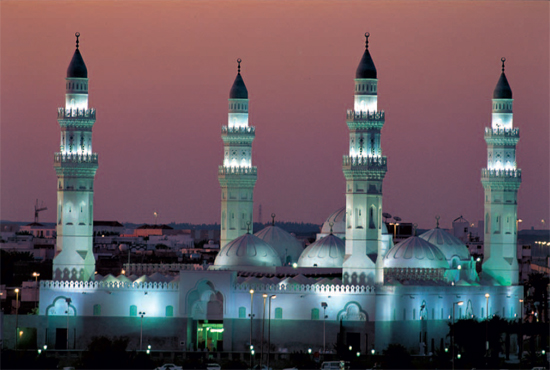
The Quba Mosque where the Blessed Prophet first prayed when he entered Medina. He gathered stones with his own hands and with the help of his followers built a simple edifice, which is considered to be the first mosque in the world.

The mihrab of the Qiblatayn Mosque (literally meaning having two qiblah or directions of prayer). During the first years of the advent of Islam, the qiblah was in the direction of Jerusalem and then by Divine Command the direction was changed toward Mecca. The original version of this mosque was used during that transitional period and therefore had two qiblah. The current edifice was constructed recently at the side of the earlier mosque.

Thai pilgrims selling merchandise from their homeland. During the pilgrimage, people are allowed to buy and sell goods which often provides for the expense of their journey. This tradition goes back to the earliest days of Islam.

Jewelers in the bazaar around the Mosque of the Prophet. Many women purchase jewelry during the pilgrimage and jewelry shops have the largest number of customers during the months of the Hajj and Ramadan.

Pilgrims from Daghestan, a Muslim land in present-day Russia. They had made the journey of 5,800 kilometers in eight days through Iran, Iraq and Jordan.

A poor family of pilgrims from Pakistan who were camping on vacant land adjacent to the Mosque of the Prophet for a week.
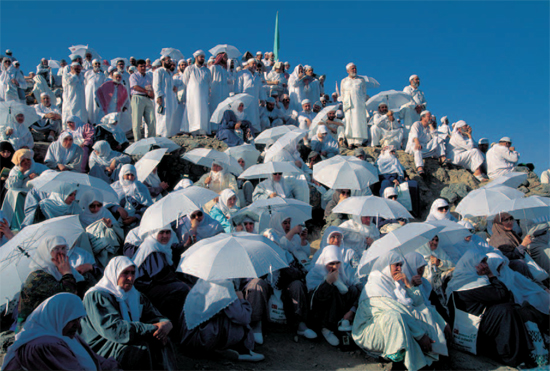
A group of Turkish pilgrims at the foot of Mount Uhud, the site in northern Medina of the famous and intense battle in Islamic history during which the idolatrous Quraysh tribe from Mecca defeated the Islamic army. During this battle, the Blessed Prophet was injured but the Meccans did not pursue the Muslims and returned to their own city.

Pilgrims praying at the tomb of the Blessed Prophet’s uncle, Hamzah, who died at the battle of Uhud along with seventy other martyrs. In this battle, which took place on 23 March AD 625, the Islamic army, consisting of a thousand men, faced an army three times in size led by the Quraysh from Mecca.

A group of Turkish pilgrims praying and mourning at the battlefield of Uhud.

A group of Chinese Muslims from Kashgar/ Kashi visiting, like almost all other pilgrims, the battlefield of Uhud.

A group of Nigerian pilgrims at Uhud.

A group of Pakistani pilgrims praying on a hilltop at Uhud.

The Miqat Mosque. Located in the Al-Aqiq valley, nine kilometers south of the Mosque of the Prophet, pilgrims bound for Mecca change here into the pilgrim’s ihram. This custom is said to have come about because on his way to Mecca the Blessed Prophet Muhammad changed into his ihram under a tree that grew here.

Pilgrims donning the ihram at the Miqat Mosque to go to Mecca for pilgrimage. Before putting on the ihram, they perform the ritual washing of their bodies (ghusl).
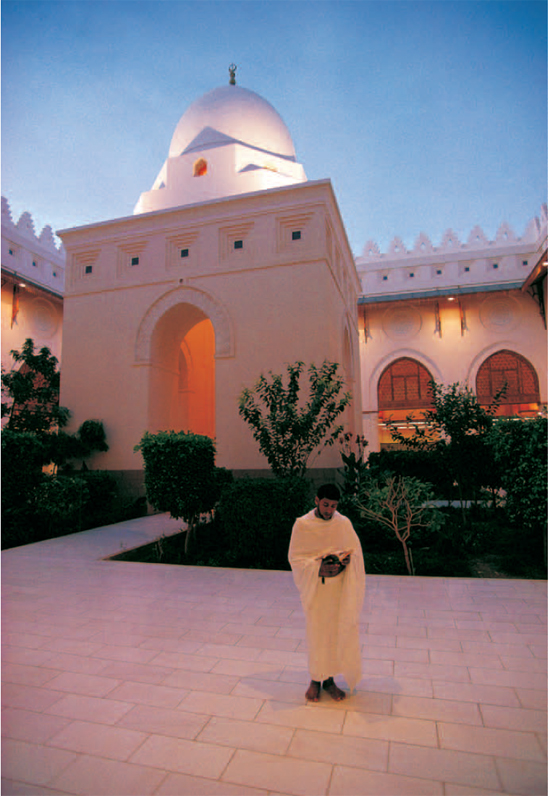
While wearing the ihram, a Muslim is forbidden from hunting, killing, arguing, violence, deceit and sexual activity.

The ihram, consisting of two pieces of seamless white cloth, is worn on the naked body and symbolizes the state of man in his primordial condition.
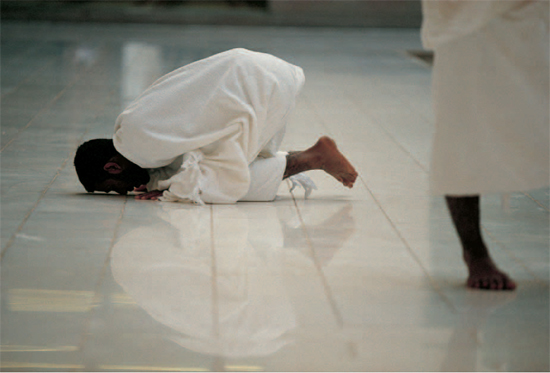
The ihram, especially of one’s first pilgrimage, is washed in Zamzam water and then put away to be used as one’s shroud. To wear the ihram itself symbolizes having died to the profane world.

When wearing the ihram, one must remove all adornments. In fact, all signs of position and status in society are removed and all men face God with their soul laid bare and independent of all worldly distinctions.

Children of foreign laborers and residents at one of the many Qur’anic schools in Medina. The children are from many nationalities, reflecting the different national backgrounds of the laborers and the many pilgrims who have come from all over the world to Medina and then have decided to remain there.

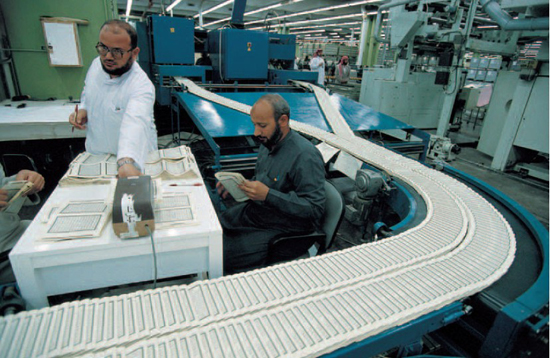

The King Fahd Complex for the Printing of the Holy Qur’an in Medina is the largest Qur’anic printing facility in the world, printing 10 million copies per year. Established in 1985, it prints in 39 languages. By 2007, it had printed 128 million copies. Missprints or missing pages are not permissible in the Holy Qur’an, so the inspection system is strict, requiring multiple stations.

A historic picture of the train leaving Medina in 1908 when the railway was called the Hijaz Railway. Some of the track between Damascus and Medina is to be found to this day.
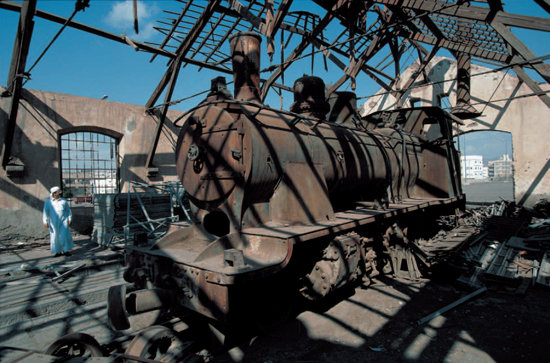
The Ottomans built a railway to link Damascus to Medina. The line was opened in 1908 and trains remained in service until 1924 when Medina fell to the forces of the Saudis. This steam engine remains in the station of the historic railway.

The opening ceremony of the Hijaz Railway in Medina in 1908. There were plans to extend the railway to Mecca, but they were never realized.

Pilgrims and the people of Medina fill the enclosure of the Mosque of the Prophet for Friday congregational prayer. The supporting pillar of each umbrella is equipped with a misting fan, so even in summer when the outside temperature reaches 45º Celsius it is close to four degrees cooler under the umbrella, providing a space for pleasant prayer.